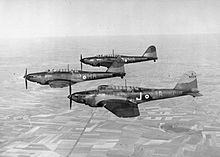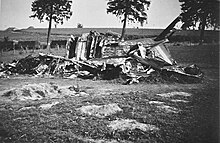Fairey Battle
| Fairey Battle | |
|---|---|
 Fairey Battle |
|
| Type: | Light bomber |
| Design country: | |
| Manufacturer: | |
| First flight: |
March 10, 1936 |
| Commissioning: |
June 1937 |
| Production time: |
1937 to 1940 |
| Number of pieces: |
2185 |
The Fairey Battle was a British fighter aircraft of the Second World War . The single - engine low - wing aircraft was developed by Fairey Aviation for the Royal Air Force in the late 1930s . The machine, used as a light bomber , had a retractable chassis. Its crew numbered two or three men.
history
The design by Fairey's chief designer Marcel Lobelle was based on the specification P.37 / 42 for a light two-seat day bomber that was supposed to replace the Hawker-Hart double-decker. The first flight took place on March 10, 1936. At this point in time, due to the accelerated expansion of the RAF, the first 155 series machines had been ordered according to specification P.23 / 35, the first of which flew in June 1937. A total of 2185 machines were manufactured by the end of production, of which 1156 were manufactured by Fairey itself and 1029 by the Austin Motor Company according to the concept of the "shadow factory" introduced for large-scale production . 18 pieces were manufactured under license at "Avions Fairey" in Belgium .
There were the variants Fairey Battle I, II, III and V, depending on whether they were equipped with a Rolls-Royce Merlin I, II, III or V. In addition, there was a variant "Fairey Battle Trainer" with two control sticks for training purposes.
commitment
From May 1937, when the first Fairey Battle Mk. I were delivered to Squadron 63 of the Royal Air Force (RAF) , to September 3, 1939, the RAF had received over 1,000 Mk. I, II and III units. 10 squadrons moved to France at the beginning of World War II , where they formed the majority of the RAF Advanced Air Striking Force .
The Fairey Battle was mainly used as a light bomber for air support of ground troops. Your payload of four 113 kg bombs, which were housed in four bomb bays in the wings, could be increased to 680 kg by external suspensions. However, the battle was inferior to the opposing aircraft of the German Air Force because it was too slow and its range too limited. During their missions in France in 1940, the RAF's Fairey Battle squadrons suffered heavy losses, whereupon the guy was replaced from combat duty. The battle was then only used as a training aircraft and as a target tug plane and - a sign of its reliable flight characteristics - flying engine test bench for engines up to 2000 hp. In these roles, the Battle remained in use until 1949.
In addition to the RAF, the air forces of Australia (368 in total) and Canada (740), as well as Belgium (16), Greece (12) and Turkey (31, used until 1947) used the battle. Poland had ordered 100 Battle for its air force to replace the outdated PZL.23 Karaś aircraft until the successor PZL.46 Sum was introduced . The machines could not be delivered before the start of the war. In the first days after the German invasion of Poland , an airplane was sent by ship to Romania , from where it was to be brought to Poland. However, this could no longer be done in time. The plane was then transferred to Turkey. Finally, Ireland came into possession of a Battle I in 1940, as a machine that was originally intended for Turkey had to make an emergency landing on Irish territory when it was transferred to the country of destination. The machine received Irish national badges and was placed under the Irish Air Corps .
Production numbers
The Battle was built in the UK at Fairey at Stockport and Austin Motors.
| version | Fairey | Austin | total |
|---|---|---|---|
| all | 1164 | 1032 | 2196 |
| year | number |
|---|---|
| 1937 | 80 |
| 1938 | 382 |
| 1939 | 1035 |
| 1940 | 699 |
| total | 2196 |
Countries of operation
Technical specifications
| Parameter | Data Fairey Battle Mk. II |
|---|---|
| crew | 3 |
| length | 12.85 m |
| span | 16.46 m |
| height | 4.72 m |
| Wing area | |
| Wing extension | |
| payload | |
| Empty mass | 3015 kg |
| Takeoff mass | 4895 kg |
| Cruising speed | |
| Top speed | 414 km / h at an altitude of 4572 m |
| Rate of climb | 280 m / min |
| Service ceiling | 7600 m |
| Range | 1609 km |
| Engines | a Rolls-Royce Merlin-I, -II, -III or -V -V-12- cylinder - motor 768 kW (1044 hp) |
| Armament | a 7.7 mm - MG Vickers K in the cabin to the rear firing a 7.7-mm-MG Browning in the right wing rigidly forward firing four 113-kg bombs as an internal, 227 kg bombs as external load |
See also
literature
- Olaf Groehler : History of the Air War 1910 to 1980 , Military Publishing House of the German Democratic Republic, Berlin 1981, p. 161.
- Kenneth Munson: Bomber, Patrol and Transport Aircraft 1939–45 , Orell Füssli Verlag, Zurich, 3rd edition 1977.
Web links
Individual evidence
- ↑ cf. Olaf Groehler: History of the Air War 1910 to 1980 , Military Publishing House of the German Democratic Republic, Berlin 1981, p. 161 and Kenneth Munson: Bomber, Patrol and Transport Aircraft 1939–45 , Orell Füssli Verlag, Zurich, 3rd edition 1977, p. 111 .
- ^ A b Public Record Office (National Archives), Kew, inventory AVIA 10/311; Existing AIR 19/524



